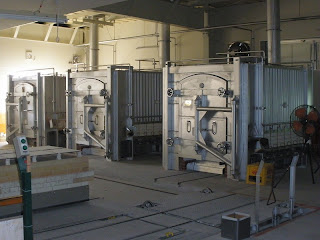This time, I introduce how to make
Hagi-ware.
Hagi-ware is a very delicate
pottery. Because of the characteristics of clay and glaze, each Hagi-ware shows
different finishing colors and tones even if they are fired in the same kiln.
Hagi-ware craftsmen say that “it is very difficult to make the wares of same tone
and pattern.” As you see the photos, even if the shape is identical, the
patterns, which are made from combinations of clay and glaze, differ sometimes
significantly.
Why these wares always show different
patterns? The reason is the difference
of temperature when they are fired in the kiln. It depends where in a kiln to
put unfired wares since the firing temperature differs in the kiln from a part
to another and the temperature variation causes different chemical reactions.
These photos show some processes of
Hagi-ware making. Using a potter’s wheel, craftsmen pay careful attention to
leveling the bottom to stabilize the ware, to making regular and
smooth at the edge for comfortable use, etc.
When they fire the wares,
traditionally a type of kiln called “nobori-gama” (climbing kiln) is used. As
you fire at the ground of the kiln, the fire goes up smoothly and effectively
to the top part. But the temperature differs from a part to another, and this
produces different tones and patterns in finished wares.
When you use a Hagi-ware, it should
be interesting to remember its real uniqueness!
Written by Yabuuchi







0 件のコメント:
コメントを投稿